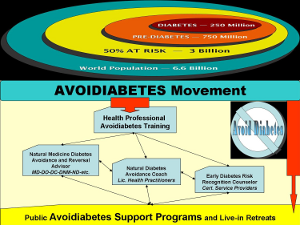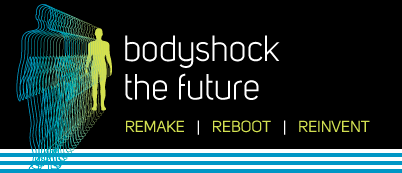 click for full image |
Would you eat off a toilet seat?As a pre-school art teacher, I know school cleanliness standards and would never ask students to eat off a changing table. When my husband was hospitalized, I found out the standards were not the same in hospitals. Everyday in hospitals and nursing homes, patients do this. The handy bedside hospital tray table is used for food service, prep space for incontinent bedding changes and prep space for wound dressing materials. In this painting, I am trying to spread awareness of this "unmentionable" problem. I hope by doing this we can increase patient safety outcomes in our most compromised patients. by: Regina Holliday | Aug 22, 2010
|
 |
The Fecanator!Create synthetic bacteria designed to live in the digestive system that converts cellulosic waste (e.g., dietary fiber) into glucose. These bacteria would a] allow us to survive on smaller portions of food and b] reduce human waste. The combination of a] and b] would increase the benefits of foreign food aid to impoverished nations while improving sanitary conditions. (Additional benefit: minimize the frequency of bowel complications in the elderly and other impacted [punny!] populations.) "Blueprints" to the bacteria (possibly multiple) would be released under a Creative Commons Non-Commercial license. (Image, per Creative Commons.) by: Steven Edwards | Jul 14, 2010
|
 |
Standing TallSitting in an office all day is unhealthy. All offices should offer employees the option of adding a platform on their desks (roughly like a piano bench - about 3' long, adjustable height, and 15" deep, with four legs that roll on tracks at each end. When the individual wants to stand, he/she pulls the platform forward and raises his/her laptop computer and papers on platform. They do the reverse to sit. I used a small table on my desk, standing about 2 hours each morning and 2 each afternoon and felt much more energized (great during headset calls!). by: George Faulkner | Sep 1, 2010
|
Decoding the Riddle of Mental IllnessAn overall communicational model of mental illness has conspicuously been lacking due to the daunting conceptual challenges at issue. As with many other such great enigmas, the solution often emerges from advances in a parallel field of inquiry – such as in Communications Theory. Indeed, a breakthrough in the understanding of affective (or emotionally charged) language has recently been proposed: wherein incorporating the communicational factors underlying mental illness within a general eight-part schematic depicted, where the grand total jumps to 408 individual terms (including 56 individual forms of mental illness). by: John E. LaMuth MSc. | Aug 31, 2010
|
 click for web site |
Meditation to Reduce Health Care UtilizationBiomedical research has validated meditation as one of the most effective and reliable preventive modalities to optimize health outcomes and decrease utilization of health care services. Decreased stress hormone levels, blood pressure, rates of insomnia, anxiety and depression and markedly reduced health insurance utilization rates point to the potential for the practice of meditation to improve global health inexpensively. Persuasively designed social networks (via iPads and smartphones) will offer motivation and facilitate compliance, as well as track and upload biomarker derived physiological data, to document better parameters of health and the reduction in use of centralized health care services. by: Jim Henning, MD | Aug 31, 2010
|
 |
biomarkers with patient and expert crowdsourcingMake free the ability to get a 1000-panel blood test quarterly. Blood testing, DNA, physicals, etc. Sensors/chromatograph/chip reader machines will need the same kind of focus as DNA sequencers. Capture the data and publish in a public website that plots trends with comparisons. Allow individuals to review the data, read professional analysis results and blog their symptoms. Statisticians, scientists and engineers can aggregate and mine the data. Over time, real cause-and-effect will emerge. Continuos improvement in this whole feedback & analysis system, could help attain unknown hieghts of health mastery. So Bill, Melinda, Warren, ...we better hurry up! :-) by: Allen Brown | Jul 25, 2010
|
 click for full image |
Videogame Style HUD for your health and life.Stress is the enemy, stress weakens, this is a known problem with the human body. The solution? Essentially a mobile phone app that displays a visual stress/environment "Heads Up Display". Using a vidoegame style HUD to help manage/guide/predict Mood, Sleep, Exercise, Food (calories, fat sugar etc) unreturned calls, phase of the moon, Biorhythms, unprocessed Emails, unread tweets, or anything else that can be reasonably represented graphically. It should display an instant simple visual 'Heads Up' showing stress points that can be focused on. By tracking stress inducing things, you feel less stress because it feels "managed" and manageable. by: Tim O'Callaghan | Jun 25, 2010
|
Earn the StarsEarn the Stars is a merit-based tool for educating, motivating, recognizing and rewarding children to make good choices about nutrition and participating in physical activities. The idea is based on both Jamie Oliver and Michelle Obama's cause. Earn the Stars is free for the users and it cost very little for the creators. It already have a prototype and it can be implemented within next year, the prototype is located at http://www.earnthestars.com. This will help transform bodies and lifestyle by educating both adults and kids about healthy food and physical activity. by: Peter Ma | Aug 31, 2010
|
 click for web site |
Avoidiabetes Movement - Recognize Risk EarlyOne in two individuals worldwide is at risk of developing diabetes or metabolic disease during their lifetime and at great socio-economic cost. Research identifies over fifty health conditions as early risk indicators for diabetes. Avoiding diabetes is possible - eight to fourteen years before a possible diagnosis - naturally and without major costly interventions. But patients are on their own. The Avoidiabetes movement aims to develop worldwide satellite systems of specialized Early Diabetes Risk Recognition and Avoidance health professionals. In addition, we are developing a system of public live-in centers teaching meal preparation, food shopping, and Avoidiabetes lifestyle management. by: Rivkah Roth | Aug 2, 2010
|
Simple Acts of Healthy Living: The 12@12 Campaign12@12 is a worksite-based demonstration project born from a crowdsourced idea called “Random Acts of Healthy Living.” Here's the premise: Almost everyone eats lunch and is at their workplace at noon. Our project encourages 12 minutes of activity at 12 o'clock once, twice or five times weekly. The employees choose: walk, stretch, stairclimb or simply breathe (relax). This campaign allows people to be active, feel better and build a community. Employees who’ve been active for 12 minutes at least once a week for 12 weeks, earn 12 minutes extra off for lunch daily…for 12 weeks…and the cycle repeats. by: Carol Harnett et al | Aug 31, 2010
|





